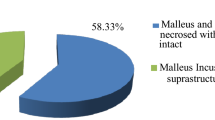Abstract
Canal wall down (CWD) mastoidectomy is the operation of choice for unsafe variety of chronic otitis media. But open mastoid cavity poses many problems. The solution of these problems is obliteration of mastoid cavity that is self-cleaning and easily maintained. In our study we aim to establish the effective technique for mastoid cavity obliteration in CWD mastoidectomy and review its efficacy in producing a dry, low maintenance cavity. This was a non-randomized longitudinal prospective study, performed over 2½ years in the department of ENT in a tertiary care hospital of Kolkata. Patients of chronic otitis media unsafe variety within the age group of 16–60 years were included in our study. Chronic otitis media unsafe variety with intratemporal or intracranial complications, and extensive cholesteatoma or granulation tissue that can’t be cleared completely during operation were excluded. There was no statistical significance for hearing improvement between CWD mastoidectomy without obliteration and CWD mastoidectomy with obliteration. There was significant statistical significance for obliteration of cavity, epithelized cavity and dry cavity between CWD mastoidectomy without obliteration and CWD mastoidectomy with obliteration. Persistent discharge and granulation were significantly more in non-obliterated group. The time taken by the ear to become dry is much shorter after mastoid cavity obliteration. Moreover, lifelong aural toilet and dependence on an ENT surgeon is avoided. Inspite of all these, a few pre-conditions must be fulfilled before embarking on this type of surgery.






Similar content being viewed by others
References
Mills RP (1988) Surgical management of discharging mastoid cavity. J Laryngol Otol 16:1–6
Mosher HP (1911) A method of filling the excavated mastoid cavity with a flap from the back of the auricle. Laryngoscope 21:1158–1163
Decher H (1985) Reduction of radical cavities by homologous cartilage chips. Laryngol Rhinol Otol (Stuttg) 64(8):423–426
Robinson JM, Moffat DA (1996) Mastoid reconstruction and obliteration. Yearb ENT 6:87–98
East CA, Brough MD, Grant HR (1991) Mastoid obliteration with temporo-parietal fascia flap. J Laryngol Otol 105:417–420
Palva T (1962) Reconstruction of the ear canal in surgery for chronic ear. Arch Otolaryngol 75:329–334
Kalpana R, Chamyal PC (1996) Mastoid osteoplasty: a study of twenty cases. Indian J Otol Head Neck Surg 48(2):137–140
Fisch U, Schimid S (1991) Radical mastoid epitympanectomy with tympanoplasty and partial obliteration: A new surgical procedure? Ann Acad Med Singap 20(5):614–617
Thorburn IB (1961) Experience with pedicled temporalis muscle flaps in radical mastoid and tympanoplasty operations. J Laryngol Otol 75:885–896
Ucar C (2006) Canal wall reconstruction and mastoid obliteration with composite multi-fractured osteoperiosteal flap. Eur Arch Otolaryngol 263(12):1082–1086
Leatherman BD, Dornhoffer JL (2004) The use of demineralized bone matrix for mastoid cavity obliteration. Otol Neurotol 25(1):22–25
Singh V, Atlas M (2007) Obliteration of persistently discharging mastoid cavity using the middle temporal artery flap. Otolaryngol Head Neck Surg 137(3):433–438
Ramsey MJ, Merchant SN, McKenna MJ (2004) Postauricular periosteal-pericranial flap for mastoid obliteration and canal wall down tympanomastoidectomy. Otol Neurotol 25:873–878
Ojala K, Palva A (1982) Late results of obliterative cholesteatoma surgery. Arch Otolaryngol 108(1):1–3
Beales PH (1959) The problem of mastoid segment after tympanoplasty. J Laryngol Otol 73:527–531
Author information
Authors and Affiliations
Corresponding author
Ethics declarations
Conflict of interest
None.
Ethical Approval
All procedures performed in studies involving human participants were in accordance with the ethical standards of the institutional and/or national research committee and with the 1964 Helsinki declaration and its later amendments or comparable ethical standards.
Informed Consent
Informed consent was obtained from all individual participants included in the study.
Rights and permissions
About this article
Cite this article
Das, C., Hazra, T.K. Relook on Mastoid Cavity Obliteration: A Prospective Study. Indian J Otolaryngol Head Neck Surg 71 (Suppl 2), 1107–1114 (2019). https://doi.org/10.1007/s12070-017-1198-y
Received:
Accepted:
Published:
Issue Date:
DOI: https://doi.org/10.1007/s12070-017-1198-y




